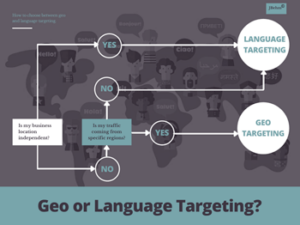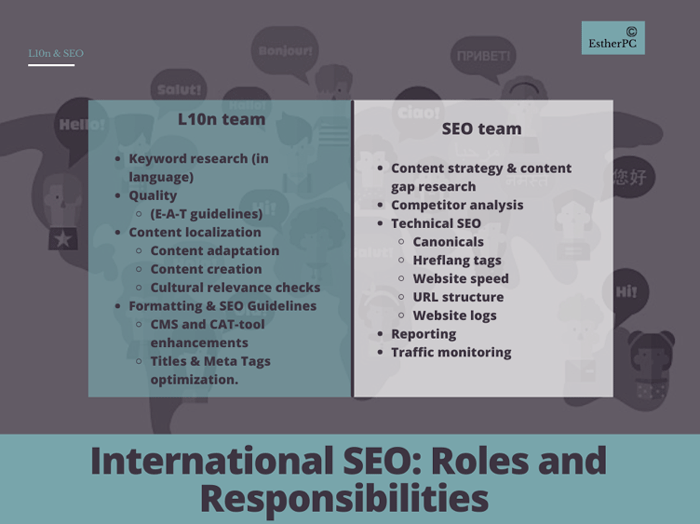The International SEO Process
The importance of digital marketing has grown exponentially in the last few years. Digital marketing can help companies create brand awareness, engage with their customers, build trust, and much more. SEO is one of the key elements of Digital Marketing. SEO not only helps you build better relationships with your target audience, it can also help you drive more people to your site, increase conversions and even test new markets with little financial investment.
SEO can seem daunting at first – even more so when you throw international markets in the mix! However, once you learn about it and break down the process into smaller, actionable tasks, it’s actually not as intimidating as it seems.
So, how does SEO work? Let’s put it this way — your company works to solve a problem for your customers. Your customers (or potential customers) go to a search engine of their choice and start typing questions to find answers to their challenges. Search engines begin tracking and monitoring these queries. The most popular ones are what we call SEO keywords. SEO keywords can be a single word (short tail), a whole string (long tail), or even a question (example: “how to stop procrastinating”). Search engines then crawl (or find) the most important pages, and rank them based on relevance. Relevancy is determined by observing how users engage with your content. Some examples are:
- Bouncing rates: do your users view only one page, or do they continue to navigate your site?
- Click-through rates: is the user navigating your website and clicking through your content?
- Domain authority: do other reputable websites recommend you and link to your content?
- Pogo-sticking: do users click on your page result and then immediately return to the search engine results page (SERP) to choose another result?
To make sure your website ranks in Google, and to ensure you can achieve a good position in the rank (ideally position 0, at the very top!), you need to make sure you have the right keywords (in each locale) for your content. Not only that, you’ll also need to make sure your content is high quality and that your users interact and engage with it. How? Read on.
Where to start
As Natalie Kelly points out in “The Risks of Targeting Too Many Markets at Once”, spreading resources too thin can result in sunk costs and other serious business losses. The benefit of web marketing, such as SEO and content localization, is that you can test a new market before making serious financial and operational commitments. This is where the localization and SEO teams can work together to leverage the potential of the web in search of new markets and business opportunities. Here are some of the actions you, as a localizer, can take with the help of your SEO team:
1 – Analyzing traffic & market prioritization
Analyzing web traffic patterns is one great way to collect data about the new market and identify market potential. Is your product website or the brand blog already receiving a significant amount of traffic from a particular geolocation? Sometimes the traffic might not be location-based, but rather language-based. Google Analytics and other similar tools can reveal a lot of details about your incoming traffic and help you prioritize markets and content. For your strategy, you might have to decide between geo and/or language targeting. Have those conversations with your SEO team and WEB teams to ensure your plan aligns with your goals. Here’s a flowchart that can help you determine which strategy is best for you:
2 – Keyword research
There are a lot of fantastic web-based keyword research tools, such as Google Keyword Planner and Semrush to cut down the labor, but the process really comes down to reading what your local customers read, talking to your clients, and conducting supportive, online research for keywords. Competitive analysis can reveal keywords that work well for your local competitors. Social media hashtags work similarly to keywords, so be sure to research these as well! For hashtag analysis, tools such as Talkwalker and Hashtagify.me can give you a great head start.
If you’re on a localization team and you have the budget and resources to do so, you can train your linguistic team on keyword research. SEO experts may not necessarily speak all the languages you support. By shifting things and putting the keyword research tasks on your linguistic team’s plate and as part of your overall localization process, you can ensure that 1) all keywords are relevant and grammatically correct, and 2) all your content is optimized upfront. This is important because it contributes to the overall quality of your content, which is key not only when it comes to SEO optimization, but also to create brand awareness and get the authority you need to become an industry leader in the geo or languages you’re targeting.
3 – Content strategy
What to translate? When translating for SEO, it’s important that you identify content clusters (also referred to as keyword grouping). Producing content around a specific keyword or group of keywords is important in order to build up your content ecosystem and create a holistic experience for your international users. Ideally, you want to cross-link between your pages of similar topics with the goal of readers spending more time on your site. Find out what content is already available on your website that you can link to and what content is missing that you should create or localize.
Once you have established content priorities based on the initial market research and once you have a content strategy (or content clusters) in place, you’ll also need to pay attention to what you localize at a web page level. Speaking in SEO terms, we want to work towards crawlability and indexability. In spoken terms, we want to make sure that the search robot can easily understand and categorize your website, individual pages, images, videos, and written content. Therefore, in addition to the body texts, headlines, and navigation elements, the localized keywords should be included in Meta Tags and image alt descriptions, HTML tags, HTTP Headers and Sitemaps to simplify the work for the search bot. You can check more details on Google’s localization guide.
Your SEO team should be very familiar with crawlability and indexability best practices, and they will make sure your site is properly indexed. However, as a localizer, the same way you have Style Guides and glossaries to ensure consistency across your content, you can also create formatting guidelines for SEO. You can have guidelines or checklists to indicate to your linguistic team, PMs, and other teams what are the key things they should be on the lookout for when localizing for SEO. Some examples would be:
- Ensure that the image alt-text is localizable. Pro-tip: this is the perfect place to sneak in a keyword!
- Ensure that page meta descriptions are localized, and that they are the optimal character length
- Ensure that the Page title is under 60 characters so that it doesn’t get cut off by Google
Think outside the box! If you use a CMS or CAT tool to localize your SEO content, you may be able to implement certain feature enhancements to, for example, ensure SEO meta data fields don’t go over the recommended maximum character count. This way, you’ll be able to flag SEO titles or meta descriptions to your linguistic team early, rather than having to shorten them after publishing!
4 – SEO Content optimization
Every localization journey and every company is different, but generally speaking, we identified three different paths for content optimization:
- Brand new content. Any brand new content should be optimized for SEO upfront through SEO optimized localization workflows. With the help of your SEO team, you can perform regular optimization checks to monitor how well the pages and the content are performing and ensure that none of the content or keywords are outdated. Essentially, all content is pre-optimized, and you keep monitoring to see how well it performs.
- Older content or legacy content. Your website might contain some older, legacy or historical content. You can audit it regularly to further optimize it and ensure it performs. With that being said, never delete old content! It is often the older publications that bring in the majority of the web visitors. SEO results can definitely take time (and patience!). If you identify outdated content, rather than deleting it, check with your SEO team. They should be able to advise what’s the best path forward – whether the content needs to be updated and optimized, or redirected to a better performing page.
- Content creation. There might be important SEO keywords for a specific locale that don’t have an equivalent in your source language. This is definitely an area where SEO and localization teams can partner together, by creating content to mind these content gaps. If this is an opportunity and you have the resources, you might want to consider creating content from scratch in that language.
All in all, SEO teams and localization teams should continuously review and optimize existing content to keep up with the algorithm updates and gain the maximum benefit from your online content real estate. Some of your pages might be performing quite well, but by tweaking the title, adding a definition or a table of content, you might achieve way better positioning in your ranking. This is where your SEO team can provide the best guidance.
Depending on the size of your company, you might not have the resources to localize every single piece of content out there. That said, with your SEO team, monitor and choose pieces that are already receiving a significant amount of traffic from a certain country location or from users whose browsers are set for another search language.
5 – Quality.
After talking about SEO keywords, indexability, crawlability… you might be shocked to know that the golden rule of SEO is…
Shocking, we know! However, it is important that you produce content for your audience. Content that sounds natural (avoid automatically generated content or, simply put, low-quality content!). As we discussed in the earlier instalment of this SEO series, this is another sweet spot where the localization team can greatly assist the SEO team. We not only have linguistic knowledge, but also cultural expertise. We can make sure that the content is high in quality and relevant to the market we’re targeting. If we start seeing SEO as part of the localization process, we can make sure that we’re not producing content just for SEO, but quality content that really works for our audiences. Go above and beyond and focus on producing content that solves your customer’s problems, as well as solving for one of your business functions!
The importance of having SEO Optimized localization workflows
To sum up, the localization team can truly be a prime asset for SEO and the team’s expertise can be leveraged in many ways, and we are not talking about just localizing and translating content. Below you can find a summary table including some of the tasks that can be shared between L10n and SEO teams. This list is not exhaustive, but hopefully it can serve as inspiration to you and your team:
FINAL TAKEAWAYS:
In conclusion, here are the three takeaways:
- SEO and Localization teams can (and should) leverage one another to boost international traffic and user experience.
- Integrating SEO into localization workflows is a good, long-term investment.
- Just like localization, SEO is all about creating a good user experience. Ideally so seamlessly, that the user feels like the content was specifically created for them.
All in all, the key to SEO success is to identify the needs of your customers and to work one step ahead of their intent; the goal is to to have your content at available at their fingertips at the exact moment they are looking to get information, to educate themselves about a topic, or to entertain themselves. Altogether, SEO is not just about embedding a list of keywords to every piece of content, but rather about creating great user and customer experiences, which at its core, is what most localization teams strive for.



